National Australia Bank CRM Report: A Comprehensive Analysis
VerifiedAdded on 2020/03/23
|16
|3528
|431
Report
AI Summary
This report provides a comprehensive analysis of Customer Relationship Management (CRM) strategies, focusing on National Australia Bank (NAB). It begins with an overview of NAB's background and a SWOT analysis of its CRM approach, highlighting strengths, weaknesses, opportunities, and threats. The report then details the CRM project objectives, including improved efficiency, profit maximization, and enhanced customer loyalty. It explores the selection of Siebel CRM, justifying its analytical capabilities and infrastructure requirements for pre- and post-implementation. The report also discusses training aspects, timeline, and budget considerations, concluding with a summary of the key findings and recommendations for NAB's CRM implementation. The report emphasizes the importance of CRM in optimizing revenue, profitability, and customer satisfaction through customer-centric strategies and the use of technology to improve customer experience and service delivery.
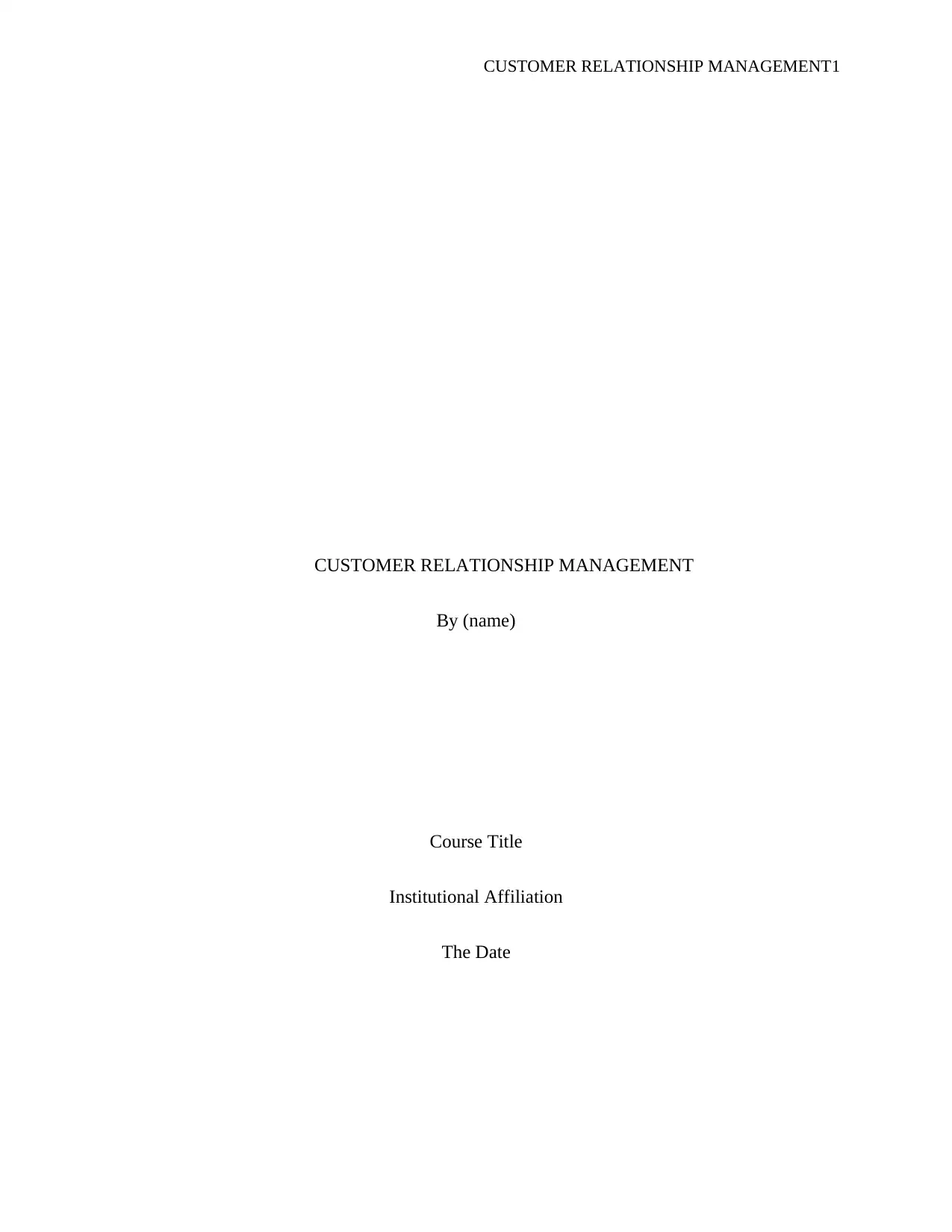
CUSTOMER RELATIONSHIP MANAGEMENT1
CUSTOMER RELATIONSHIP MANAGEMENT
By (name)
Course Title
Institutional Affiliation
The Date
CUSTOMER RELATIONSHIP MANAGEMENT
By (name)
Course Title
Institutional Affiliation
The Date
Paraphrase This Document
Need a fresh take? Get an instant paraphrase of this document with our AI Paraphraser
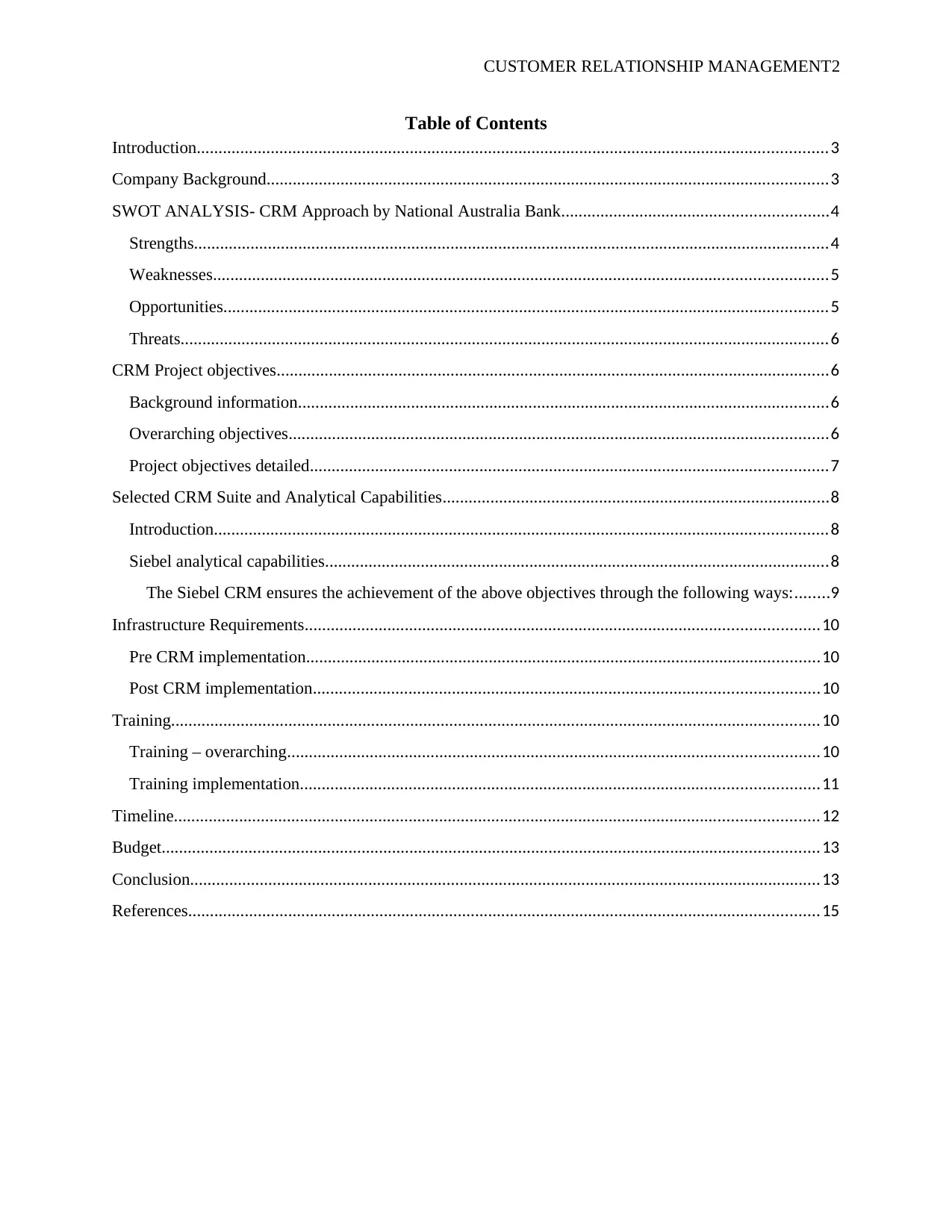
CUSTOMER RELATIONSHIP MANAGEMENT2
Table of Contents
Introduction.................................................................................................................................................3
Company Background.................................................................................................................................3
SWOT ANALYSIS- CRM Approach by National Australia Bank.............................................................4
Strengths..................................................................................................................................................4
Weaknesses.............................................................................................................................................5
Opportunities...........................................................................................................................................5
Threats.....................................................................................................................................................6
CRM Project objectives...............................................................................................................................6
Background information..........................................................................................................................6
Overarching objectives............................................................................................................................6
Project objectives detailed.......................................................................................................................7
Selected CRM Suite and Analytical Capabilities.........................................................................................8
Introduction.............................................................................................................................................8
Siebel analytical capabilities....................................................................................................................8
The Siebel CRM ensures the achievement of the above objectives through the following ways:........9
Infrastructure Requirements......................................................................................................................10
Pre CRM implementation......................................................................................................................10
Post CRM implementation....................................................................................................................10
Training.....................................................................................................................................................10
Training – overarching..........................................................................................................................10
Training implementation.......................................................................................................................11
Timeline....................................................................................................................................................12
Budget.......................................................................................................................................................13
Conclusion.................................................................................................................................................13
References.................................................................................................................................................15
Table of Contents
Introduction.................................................................................................................................................3
Company Background.................................................................................................................................3
SWOT ANALYSIS- CRM Approach by National Australia Bank.............................................................4
Strengths..................................................................................................................................................4
Weaknesses.............................................................................................................................................5
Opportunities...........................................................................................................................................5
Threats.....................................................................................................................................................6
CRM Project objectives...............................................................................................................................6
Background information..........................................................................................................................6
Overarching objectives............................................................................................................................6
Project objectives detailed.......................................................................................................................7
Selected CRM Suite and Analytical Capabilities.........................................................................................8
Introduction.............................................................................................................................................8
Siebel analytical capabilities....................................................................................................................8
The Siebel CRM ensures the achievement of the above objectives through the following ways:........9
Infrastructure Requirements......................................................................................................................10
Pre CRM implementation......................................................................................................................10
Post CRM implementation....................................................................................................................10
Training.....................................................................................................................................................10
Training – overarching..........................................................................................................................10
Training implementation.......................................................................................................................11
Timeline....................................................................................................................................................12
Budget.......................................................................................................................................................13
Conclusion.................................................................................................................................................13
References.................................................................................................................................................15
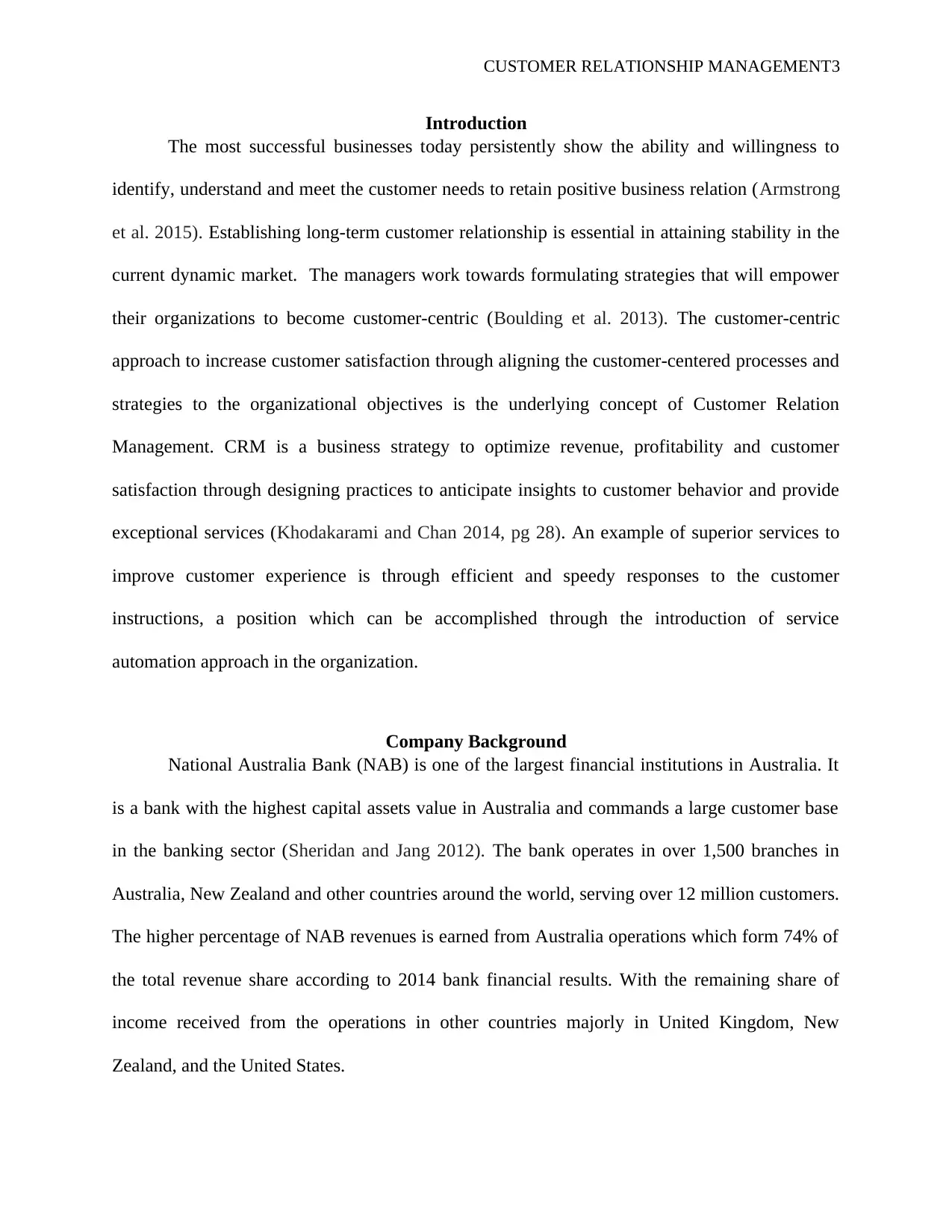
CUSTOMER RELATIONSHIP MANAGEMENT3
Introduction
The most successful businesses today persistently show the ability and willingness to
identify, understand and meet the customer needs to retain positive business relation (Armstrong
et al. 2015). Establishing long-term customer relationship is essential in attaining stability in the
current dynamic market. The managers work towards formulating strategies that will empower
their organizations to become customer-centric (Boulding et al. 2013). The customer-centric
approach to increase customer satisfaction through aligning the customer-centered processes and
strategies to the organizational objectives is the underlying concept of Customer Relation
Management. CRM is a business strategy to optimize revenue, profitability and customer
satisfaction through designing practices to anticipate insights to customer behavior and provide
exceptional services (Khodakarami and Chan 2014, pg 28). An example of superior services to
improve customer experience is through efficient and speedy responses to the customer
instructions, a position which can be accomplished through the introduction of service
automation approach in the organization.
Company Background
National Australia Bank (NAB) is one of the largest financial institutions in Australia. It
is a bank with the highest capital assets value in Australia and commands a large customer base
in the banking sector (Sheridan and Jang 2012). The bank operates in over 1,500 branches in
Australia, New Zealand and other countries around the world, serving over 12 million customers.
The higher percentage of NAB revenues is earned from Australia operations which form 74% of
the total revenue share according to 2014 bank financial results. With the remaining share of
income received from the operations in other countries majorly in United Kingdom, New
Zealand, and the United States.
Introduction
The most successful businesses today persistently show the ability and willingness to
identify, understand and meet the customer needs to retain positive business relation (Armstrong
et al. 2015). Establishing long-term customer relationship is essential in attaining stability in the
current dynamic market. The managers work towards formulating strategies that will empower
their organizations to become customer-centric (Boulding et al. 2013). The customer-centric
approach to increase customer satisfaction through aligning the customer-centered processes and
strategies to the organizational objectives is the underlying concept of Customer Relation
Management. CRM is a business strategy to optimize revenue, profitability and customer
satisfaction through designing practices to anticipate insights to customer behavior and provide
exceptional services (Khodakarami and Chan 2014, pg 28). An example of superior services to
improve customer experience is through efficient and speedy responses to the customer
instructions, a position which can be accomplished through the introduction of service
automation approach in the organization.
Company Background
National Australia Bank (NAB) is one of the largest financial institutions in Australia. It
is a bank with the highest capital assets value in Australia and commands a large customer base
in the banking sector (Sheridan and Jang 2012). The bank operates in over 1,500 branches in
Australia, New Zealand and other countries around the world, serving over 12 million customers.
The higher percentage of NAB revenues is earned from Australia operations which form 74% of
the total revenue share according to 2014 bank financial results. With the remaining share of
income received from the operations in other countries majorly in United Kingdom, New
Zealand, and the United States.
⊘ This is a preview!⊘
Do you want full access?
Subscribe today to unlock all pages.

Trusted by 1+ million students worldwide
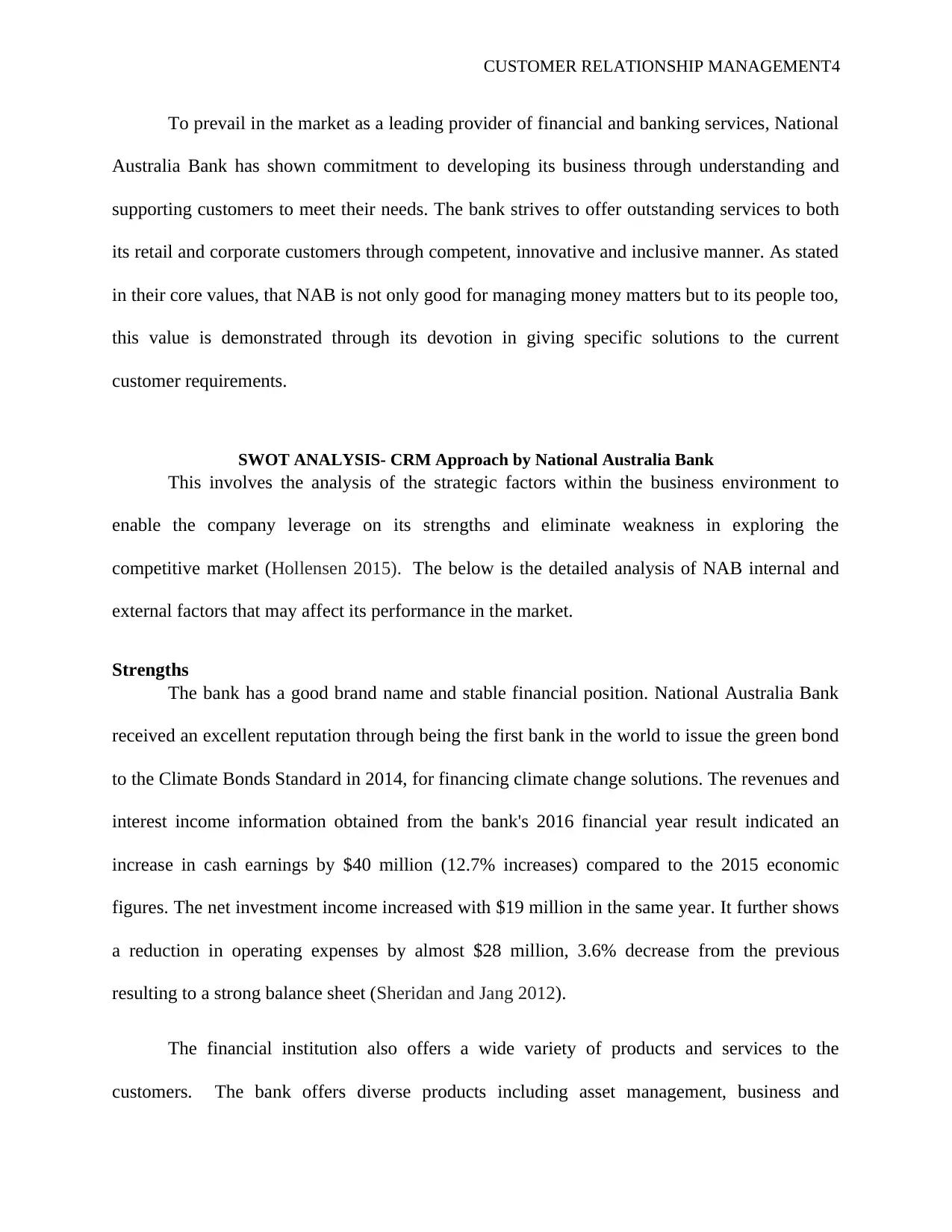
CUSTOMER RELATIONSHIP MANAGEMENT4
To prevail in the market as a leading provider of financial and banking services, National
Australia Bank has shown commitment to developing its business through understanding and
supporting customers to meet their needs. The bank strives to offer outstanding services to both
its retail and corporate customers through competent, innovative and inclusive manner. As stated
in their core values, that NAB is not only good for managing money matters but to its people too,
this value is demonstrated through its devotion in giving specific solutions to the current
customer requirements.
SWOT ANALYSIS- CRM Approach by National Australia Bank
This involves the analysis of the strategic factors within the business environment to
enable the company leverage on its strengths and eliminate weakness in exploring the
competitive market (Hollensen 2015). The below is the detailed analysis of NAB internal and
external factors that may affect its performance in the market.
Strengths
The bank has a good brand name and stable financial position. National Australia Bank
received an excellent reputation through being the first bank in the world to issue the green bond
to the Climate Bonds Standard in 2014, for financing climate change solutions. The revenues and
interest income information obtained from the bank's 2016 financial year result indicated an
increase in cash earnings by $40 million (12.7% increases) compared to the 2015 economic
figures. The net investment income increased with $19 million in the same year. It further shows
a reduction in operating expenses by almost $28 million, 3.6% decrease from the previous
resulting to a strong balance sheet (Sheridan and Jang 2012).
The financial institution also offers a wide variety of products and services to the
customers. The bank offers diverse products including asset management, business and
To prevail in the market as a leading provider of financial and banking services, National
Australia Bank has shown commitment to developing its business through understanding and
supporting customers to meet their needs. The bank strives to offer outstanding services to both
its retail and corporate customers through competent, innovative and inclusive manner. As stated
in their core values, that NAB is not only good for managing money matters but to its people too,
this value is demonstrated through its devotion in giving specific solutions to the current
customer requirements.
SWOT ANALYSIS- CRM Approach by National Australia Bank
This involves the analysis of the strategic factors within the business environment to
enable the company leverage on its strengths and eliminate weakness in exploring the
competitive market (Hollensen 2015). The below is the detailed analysis of NAB internal and
external factors that may affect its performance in the market.
Strengths
The bank has a good brand name and stable financial position. National Australia Bank
received an excellent reputation through being the first bank in the world to issue the green bond
to the Climate Bonds Standard in 2014, for financing climate change solutions. The revenues and
interest income information obtained from the bank's 2016 financial year result indicated an
increase in cash earnings by $40 million (12.7% increases) compared to the 2015 economic
figures. The net investment income increased with $19 million in the same year. It further shows
a reduction in operating expenses by almost $28 million, 3.6% decrease from the previous
resulting to a strong balance sheet (Sheridan and Jang 2012).
The financial institution also offers a wide variety of products and services to the
customers. The bank offers diverse products including asset management, business and
Paraphrase This Document
Need a fresh take? Get an instant paraphrase of this document with our AI Paraphraser
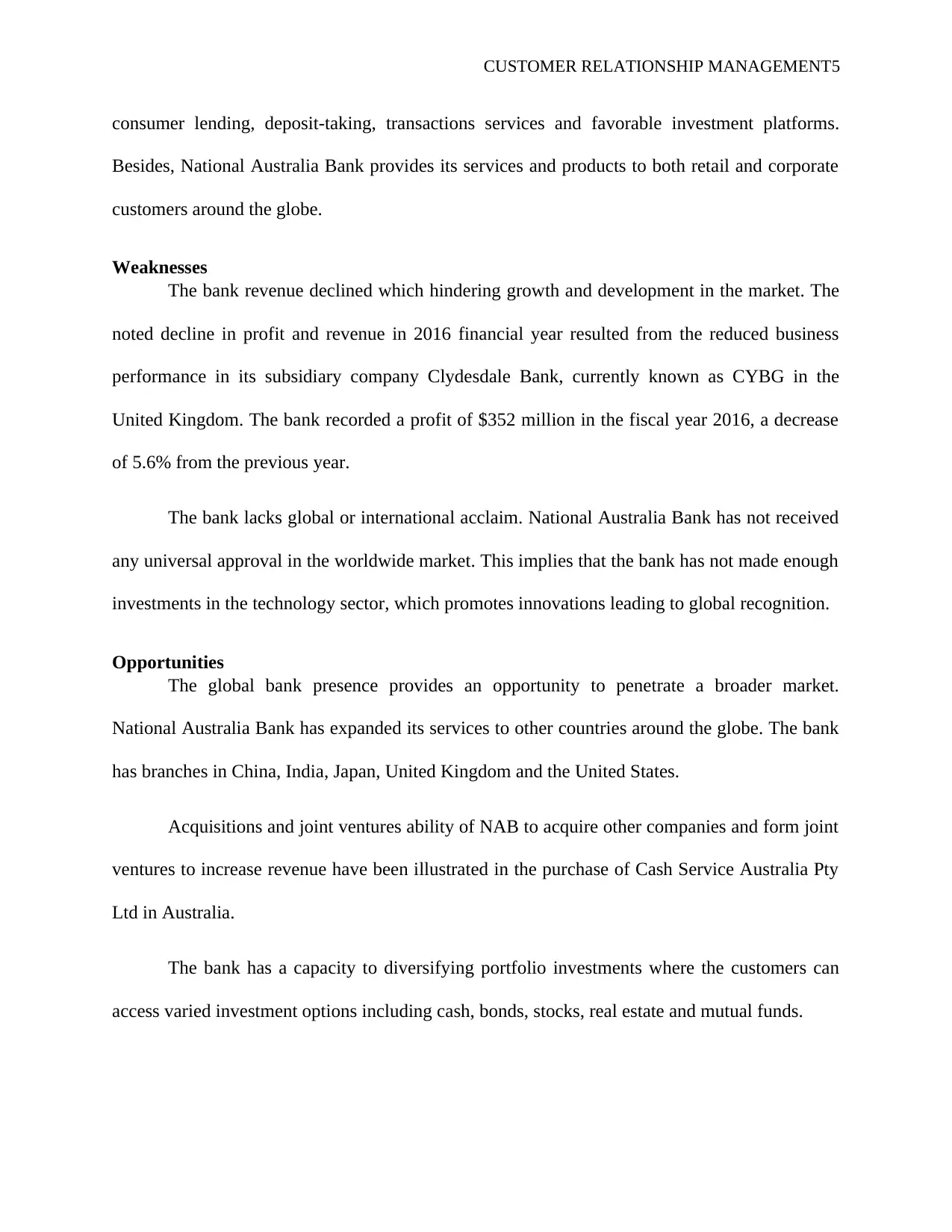
CUSTOMER RELATIONSHIP MANAGEMENT5
consumer lending, deposit-taking, transactions services and favorable investment platforms.
Besides, National Australia Bank provides its services and products to both retail and corporate
customers around the globe.
Weaknesses
The bank revenue declined which hindering growth and development in the market. The
noted decline in profit and revenue in 2016 financial year resulted from the reduced business
performance in its subsidiary company Clydesdale Bank, currently known as CYBG in the
United Kingdom. The bank recorded a profit of $352 million in the fiscal year 2016, a decrease
of 5.6% from the previous year.
The bank lacks global or international acclaim. National Australia Bank has not received
any universal approval in the worldwide market. This implies that the bank has not made enough
investments in the technology sector, which promotes innovations leading to global recognition.
Opportunities
The global bank presence provides an opportunity to penetrate a broader market.
National Australia Bank has expanded its services to other countries around the globe. The bank
has branches in China, India, Japan, United Kingdom and the United States.
Acquisitions and joint ventures ability of NAB to acquire other companies and form joint
ventures to increase revenue have been illustrated in the purchase of Cash Service Australia Pty
Ltd in Australia.
The bank has a capacity to diversifying portfolio investments where the customers can
access varied investment options including cash, bonds, stocks, real estate and mutual funds.
consumer lending, deposit-taking, transactions services and favorable investment platforms.
Besides, National Australia Bank provides its services and products to both retail and corporate
customers around the globe.
Weaknesses
The bank revenue declined which hindering growth and development in the market. The
noted decline in profit and revenue in 2016 financial year resulted from the reduced business
performance in its subsidiary company Clydesdale Bank, currently known as CYBG in the
United Kingdom. The bank recorded a profit of $352 million in the fiscal year 2016, a decrease
of 5.6% from the previous year.
The bank lacks global or international acclaim. National Australia Bank has not received
any universal approval in the worldwide market. This implies that the bank has not made enough
investments in the technology sector, which promotes innovations leading to global recognition.
Opportunities
The global bank presence provides an opportunity to penetrate a broader market.
National Australia Bank has expanded its services to other countries around the globe. The bank
has branches in China, India, Japan, United Kingdom and the United States.
Acquisitions and joint ventures ability of NAB to acquire other companies and form joint
ventures to increase revenue have been illustrated in the purchase of Cash Service Australia Pty
Ltd in Australia.
The bank has a capacity to diversifying portfolio investments where the customers can
access varied investment options including cash, bonds, stocks, real estate and mutual funds.
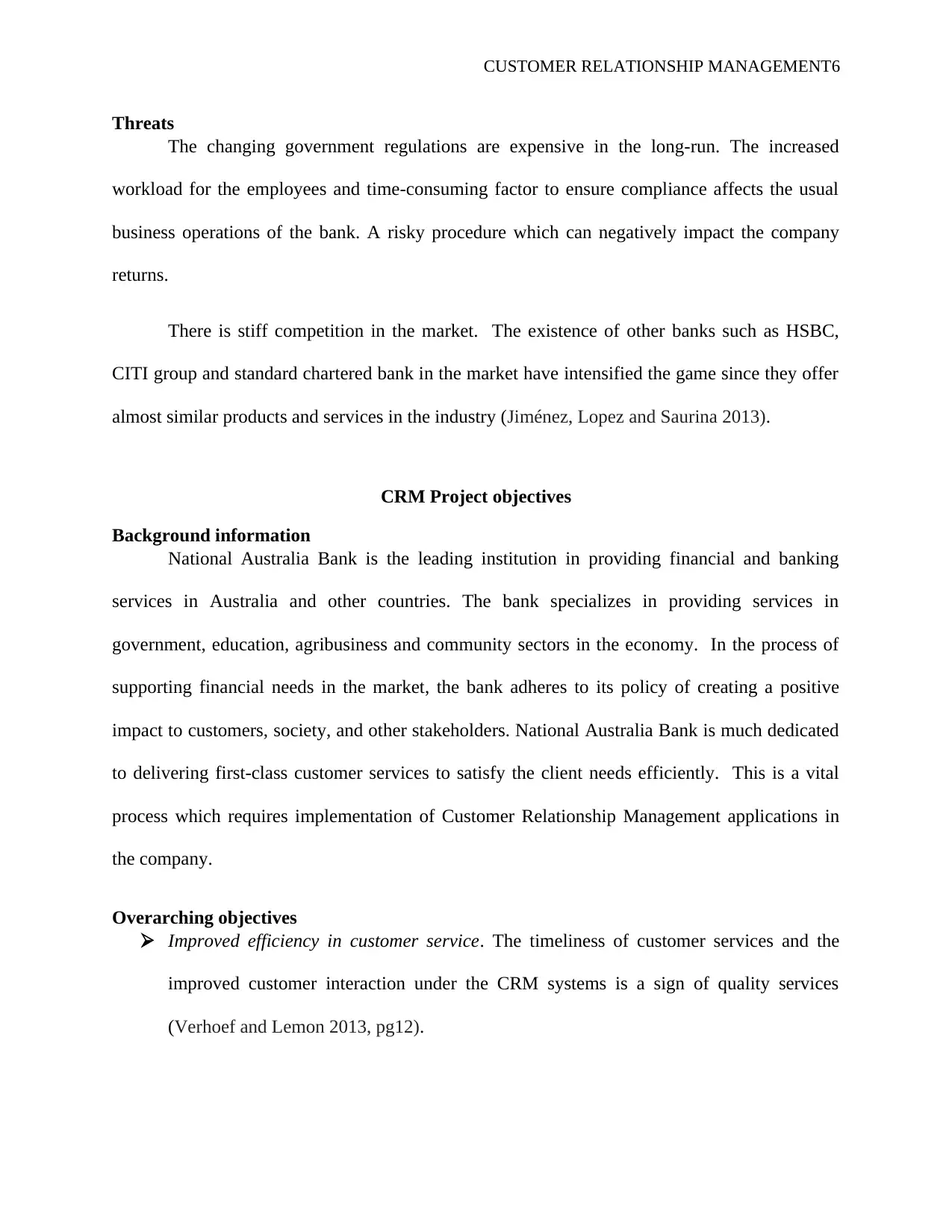
CUSTOMER RELATIONSHIP MANAGEMENT6
Threats
The changing government regulations are expensive in the long-run. The increased
workload for the employees and time-consuming factor to ensure compliance affects the usual
business operations of the bank. A risky procedure which can negatively impact the company
returns.
There is stiff competition in the market. The existence of other banks such as HSBC,
CITI group and standard chartered bank in the market have intensified the game since they offer
almost similar products and services in the industry (Jiménez, Lopez and Saurina 2013).
CRM Project objectives
Background information
National Australia Bank is the leading institution in providing financial and banking
services in Australia and other countries. The bank specializes in providing services in
government, education, agribusiness and community sectors in the economy. In the process of
supporting financial needs in the market, the bank adheres to its policy of creating a positive
impact to customers, society, and other stakeholders. National Australia Bank is much dedicated
to delivering first-class customer services to satisfy the client needs efficiently. This is a vital
process which requires implementation of Customer Relationship Management applications in
the company.
Overarching objectives
Improved efficiency in customer service. The timeliness of customer services and the
improved customer interaction under the CRM systems is a sign of quality services
(Verhoef and Lemon 2013, pg12).
Threats
The changing government regulations are expensive in the long-run. The increased
workload for the employees and time-consuming factor to ensure compliance affects the usual
business operations of the bank. A risky procedure which can negatively impact the company
returns.
There is stiff competition in the market. The existence of other banks such as HSBC,
CITI group and standard chartered bank in the market have intensified the game since they offer
almost similar products and services in the industry (Jiménez, Lopez and Saurina 2013).
CRM Project objectives
Background information
National Australia Bank is the leading institution in providing financial and banking
services in Australia and other countries. The bank specializes in providing services in
government, education, agribusiness and community sectors in the economy. In the process of
supporting financial needs in the market, the bank adheres to its policy of creating a positive
impact to customers, society, and other stakeholders. National Australia Bank is much dedicated
to delivering first-class customer services to satisfy the client needs efficiently. This is a vital
process which requires implementation of Customer Relationship Management applications in
the company.
Overarching objectives
Improved efficiency in customer service. The timeliness of customer services and the
improved customer interaction under the CRM systems is a sign of quality services
(Verhoef and Lemon 2013, pg12).
⊘ This is a preview!⊘
Do you want full access?
Subscribe today to unlock all pages.

Trusted by 1+ million students worldwide
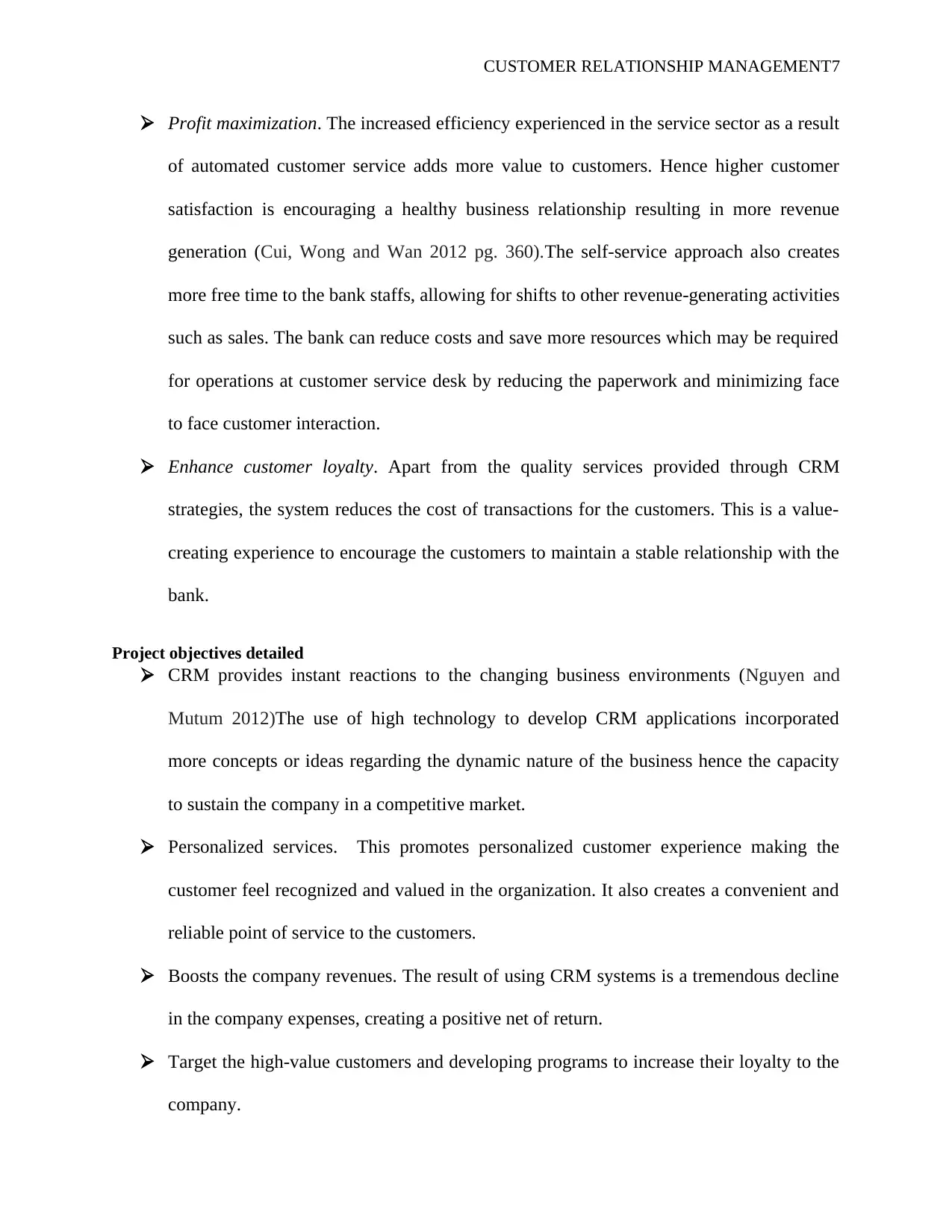
CUSTOMER RELATIONSHIP MANAGEMENT7
Profit maximization. The increased efficiency experienced in the service sector as a result
of automated customer service adds more value to customers. Hence higher customer
satisfaction is encouraging a healthy business relationship resulting in more revenue
generation (Cui, Wong and Wan 2012 pg. 360).The self-service approach also creates
more free time to the bank staffs, allowing for shifts to other revenue-generating activities
such as sales. The bank can reduce costs and save more resources which may be required
for operations at customer service desk by reducing the paperwork and minimizing face
to face customer interaction.
Enhance customer loyalty. Apart from the quality services provided through CRM
strategies, the system reduces the cost of transactions for the customers. This is a value-
creating experience to encourage the customers to maintain a stable relationship with the
bank.
Project objectives detailed
CRM provides instant reactions to the changing business environments (Nguyen and
Mutum 2012)The use of high technology to develop CRM applications incorporated
more concepts or ideas regarding the dynamic nature of the business hence the capacity
to sustain the company in a competitive market.
Personalized services. This promotes personalized customer experience making the
customer feel recognized and valued in the organization. It also creates a convenient and
reliable point of service to the customers.
Boosts the company revenues. The result of using CRM systems is a tremendous decline
in the company expenses, creating a positive net of return.
Target the high-value customers and developing programs to increase their loyalty to the
company.
Profit maximization. The increased efficiency experienced in the service sector as a result
of automated customer service adds more value to customers. Hence higher customer
satisfaction is encouraging a healthy business relationship resulting in more revenue
generation (Cui, Wong and Wan 2012 pg. 360).The self-service approach also creates
more free time to the bank staffs, allowing for shifts to other revenue-generating activities
such as sales. The bank can reduce costs and save more resources which may be required
for operations at customer service desk by reducing the paperwork and minimizing face
to face customer interaction.
Enhance customer loyalty. Apart from the quality services provided through CRM
strategies, the system reduces the cost of transactions for the customers. This is a value-
creating experience to encourage the customers to maintain a stable relationship with the
bank.
Project objectives detailed
CRM provides instant reactions to the changing business environments (Nguyen and
Mutum 2012)The use of high technology to develop CRM applications incorporated
more concepts or ideas regarding the dynamic nature of the business hence the capacity
to sustain the company in a competitive market.
Personalized services. This promotes personalized customer experience making the
customer feel recognized and valued in the organization. It also creates a convenient and
reliable point of service to the customers.
Boosts the company revenues. The result of using CRM systems is a tremendous decline
in the company expenses, creating a positive net of return.
Target the high-value customers and developing programs to increase their loyalty to the
company.
Paraphrase This Document
Need a fresh take? Get an instant paraphrase of this document with our AI Paraphraser
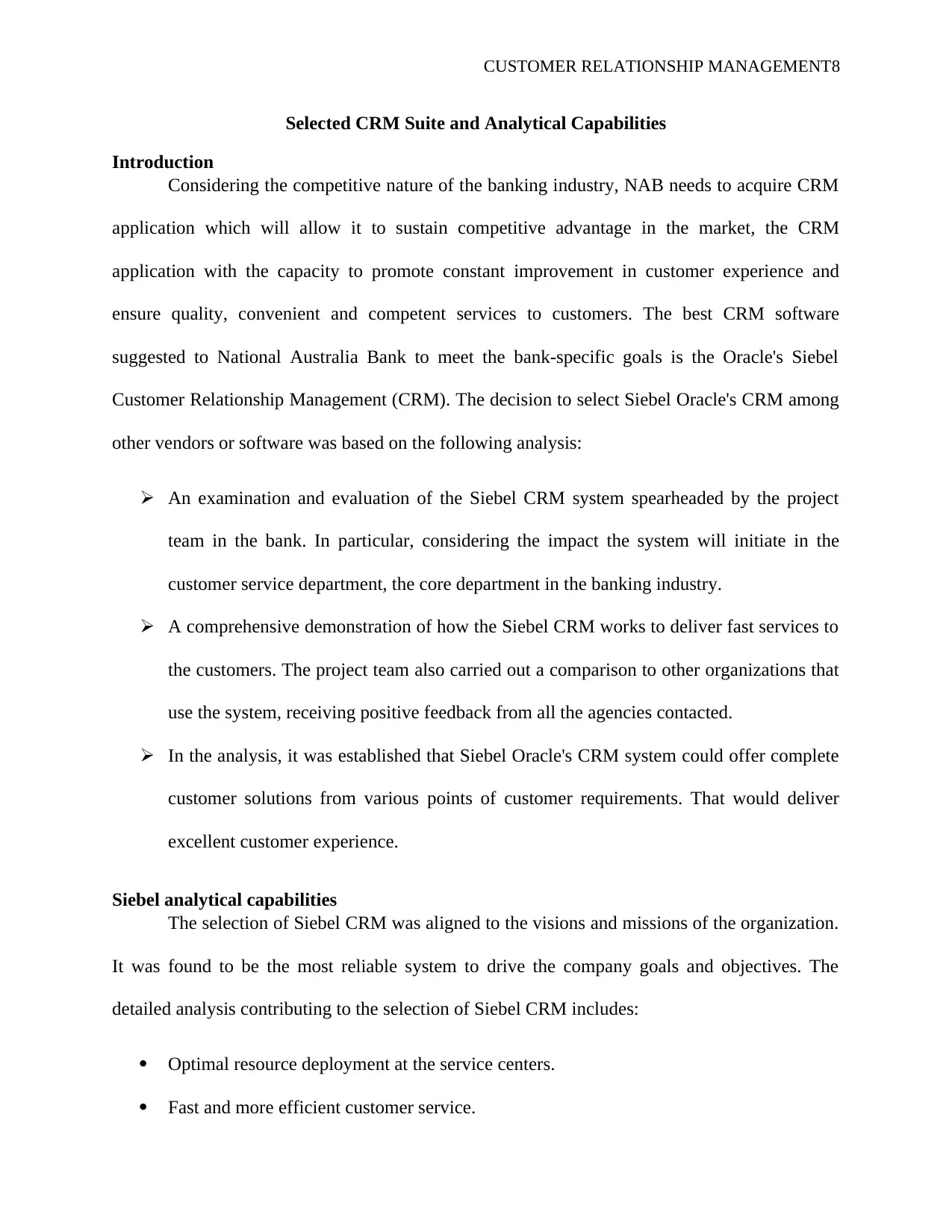
CUSTOMER RELATIONSHIP MANAGEMENT8
Selected CRM Suite and Analytical Capabilities
Introduction
Considering the competitive nature of the banking industry, NAB needs to acquire CRM
application which will allow it to sustain competitive advantage in the market, the CRM
application with the capacity to promote constant improvement in customer experience and
ensure quality, convenient and competent services to customers. The best CRM software
suggested to National Australia Bank to meet the bank-specific goals is the Oracle's Siebel
Customer Relationship Management (CRM). The decision to select Siebel Oracle's CRM among
other vendors or software was based on the following analysis:
An examination and evaluation of the Siebel CRM system spearheaded by the project
team in the bank. In particular, considering the impact the system will initiate in the
customer service department, the core department in the banking industry.
A comprehensive demonstration of how the Siebel CRM works to deliver fast services to
the customers. The project team also carried out a comparison to other organizations that
use the system, receiving positive feedback from all the agencies contacted.
In the analysis, it was established that Siebel Oracle's CRM system could offer complete
customer solutions from various points of customer requirements. That would deliver
excellent customer experience.
Siebel analytical capabilities
The selection of Siebel CRM was aligned to the visions and missions of the organization.
It was found to be the most reliable system to drive the company goals and objectives. The
detailed analysis contributing to the selection of Siebel CRM includes:
Optimal resource deployment at the service centers.
Fast and more efficient customer service.
Selected CRM Suite and Analytical Capabilities
Introduction
Considering the competitive nature of the banking industry, NAB needs to acquire CRM
application which will allow it to sustain competitive advantage in the market, the CRM
application with the capacity to promote constant improvement in customer experience and
ensure quality, convenient and competent services to customers. The best CRM software
suggested to National Australia Bank to meet the bank-specific goals is the Oracle's Siebel
Customer Relationship Management (CRM). The decision to select Siebel Oracle's CRM among
other vendors or software was based on the following analysis:
An examination and evaluation of the Siebel CRM system spearheaded by the project
team in the bank. In particular, considering the impact the system will initiate in the
customer service department, the core department in the banking industry.
A comprehensive demonstration of how the Siebel CRM works to deliver fast services to
the customers. The project team also carried out a comparison to other organizations that
use the system, receiving positive feedback from all the agencies contacted.
In the analysis, it was established that Siebel Oracle's CRM system could offer complete
customer solutions from various points of customer requirements. That would deliver
excellent customer experience.
Siebel analytical capabilities
The selection of Siebel CRM was aligned to the visions and missions of the organization.
It was found to be the most reliable system to drive the company goals and objectives. The
detailed analysis contributing to the selection of Siebel CRM includes:
Optimal resource deployment at the service centers.
Fast and more efficient customer service.
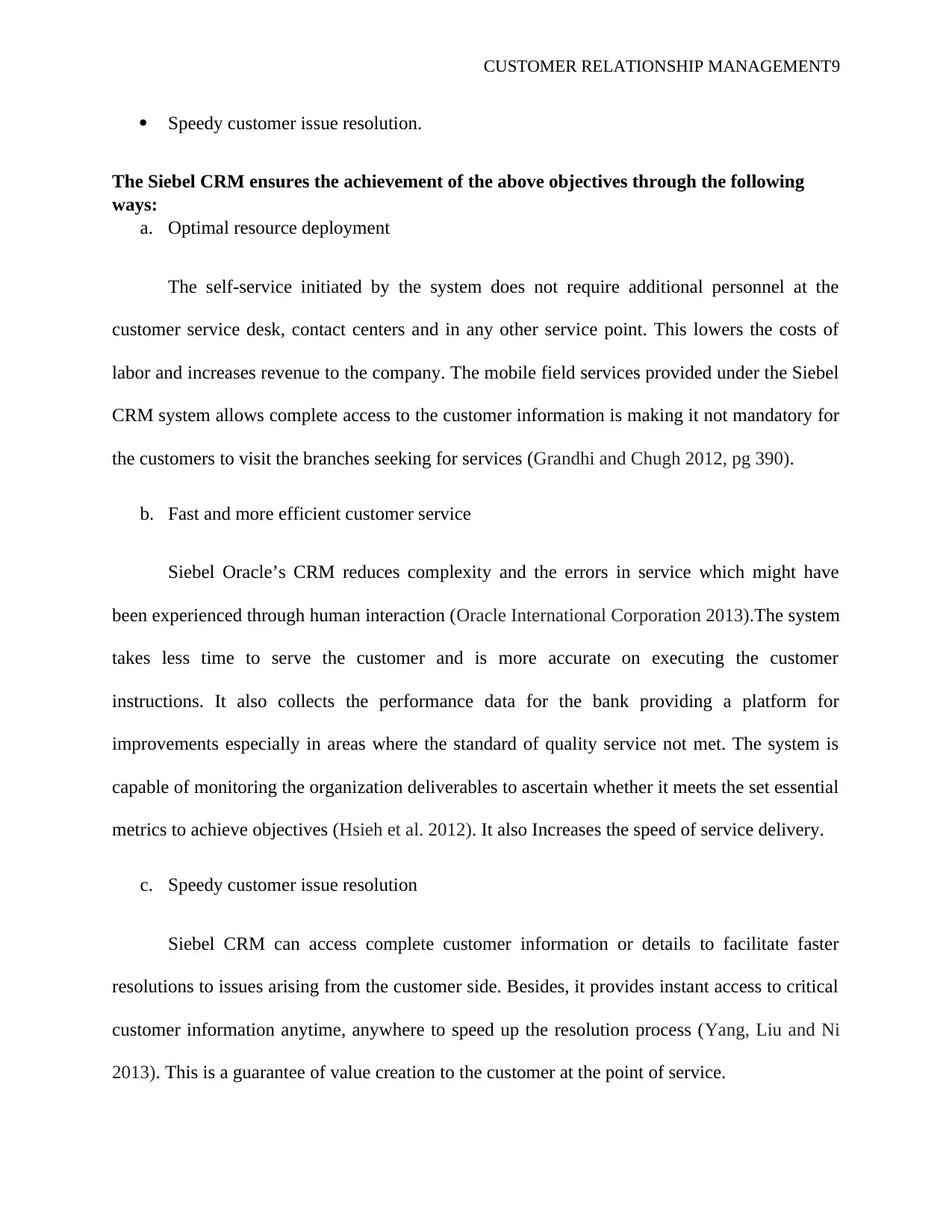
CUSTOMER RELATIONSHIP MANAGEMENT9
Speedy customer issue resolution.
The Siebel CRM ensures the achievement of the above objectives through the following
ways:
a. Optimal resource deployment
The self-service initiated by the system does not require additional personnel at the
customer service desk, contact centers and in any other service point. This lowers the costs of
labor and increases revenue to the company. The mobile field services provided under the Siebel
CRM system allows complete access to the customer information is making it not mandatory for
the customers to visit the branches seeking for services (Grandhi and Chugh 2012, pg 390).
b. Fast and more efficient customer service
Siebel Oracle’s CRM reduces complexity and the errors in service which might have
been experienced through human interaction (Oracle International Corporation 2013).The system
takes less time to serve the customer and is more accurate on executing the customer
instructions. It also collects the performance data for the bank providing a platform for
improvements especially in areas where the standard of quality service not met. The system is
capable of monitoring the organization deliverables to ascertain whether it meets the set essential
metrics to achieve objectives (Hsieh et al. 2012). It also Increases the speed of service delivery.
c. Speedy customer issue resolution
Siebel CRM can access complete customer information or details to facilitate faster
resolutions to issues arising from the customer side. Besides, it provides instant access to critical
customer information anytime, anywhere to speed up the resolution process (Yang, Liu and Ni
2013). This is a guarantee of value creation to the customer at the point of service.
Speedy customer issue resolution.
The Siebel CRM ensures the achievement of the above objectives through the following
ways:
a. Optimal resource deployment
The self-service initiated by the system does not require additional personnel at the
customer service desk, contact centers and in any other service point. This lowers the costs of
labor and increases revenue to the company. The mobile field services provided under the Siebel
CRM system allows complete access to the customer information is making it not mandatory for
the customers to visit the branches seeking for services (Grandhi and Chugh 2012, pg 390).
b. Fast and more efficient customer service
Siebel Oracle’s CRM reduces complexity and the errors in service which might have
been experienced through human interaction (Oracle International Corporation 2013).The system
takes less time to serve the customer and is more accurate on executing the customer
instructions. It also collects the performance data for the bank providing a platform for
improvements especially in areas where the standard of quality service not met. The system is
capable of monitoring the organization deliverables to ascertain whether it meets the set essential
metrics to achieve objectives (Hsieh et al. 2012). It also Increases the speed of service delivery.
c. Speedy customer issue resolution
Siebel CRM can access complete customer information or details to facilitate faster
resolutions to issues arising from the customer side. Besides, it provides instant access to critical
customer information anytime, anywhere to speed up the resolution process (Yang, Liu and Ni
2013). This is a guarantee of value creation to the customer at the point of service.
⊘ This is a preview!⊘
Do you want full access?
Subscribe today to unlock all pages.

Trusted by 1+ million students worldwide
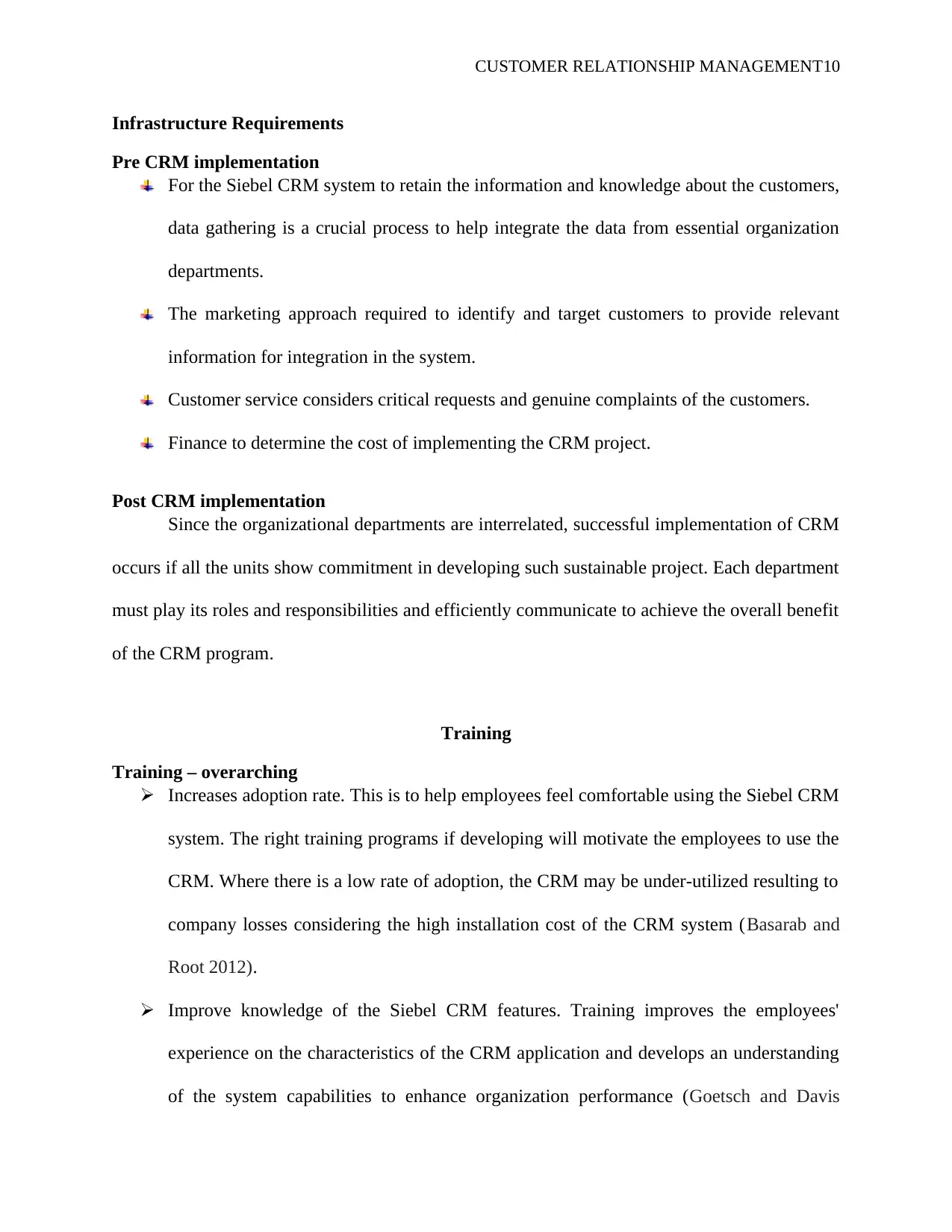
CUSTOMER RELATIONSHIP MANAGEMENT10
Infrastructure Requirements
Pre CRM implementation
For the Siebel CRM system to retain the information and knowledge about the customers,
data gathering is a crucial process to help integrate the data from essential organization
departments.
The marketing approach required to identify and target customers to provide relevant
information for integration in the system.
Customer service considers critical requests and genuine complaints of the customers.
Finance to determine the cost of implementing the CRM project.
Post CRM implementation
Since the organizational departments are interrelated, successful implementation of CRM
occurs if all the units show commitment in developing such sustainable project. Each department
must play its roles and responsibilities and efficiently communicate to achieve the overall benefit
of the CRM program.
Training
Training – overarching
Increases adoption rate. This is to help employees feel comfortable using the Siebel CRM
system. The right training programs if developing will motivate the employees to use the
CRM. Where there is a low rate of adoption, the CRM may be under-utilized resulting to
company losses considering the high installation cost of the CRM system (Basarab and
Root 2012).
Improve knowledge of the Siebel CRM features. Training improves the employees'
experience on the characteristics of the CRM application and develops an understanding
of the system capabilities to enhance organization performance (Goetsch and Davis
Infrastructure Requirements
Pre CRM implementation
For the Siebel CRM system to retain the information and knowledge about the customers,
data gathering is a crucial process to help integrate the data from essential organization
departments.
The marketing approach required to identify and target customers to provide relevant
information for integration in the system.
Customer service considers critical requests and genuine complaints of the customers.
Finance to determine the cost of implementing the CRM project.
Post CRM implementation
Since the organizational departments are interrelated, successful implementation of CRM
occurs if all the units show commitment in developing such sustainable project. Each department
must play its roles and responsibilities and efficiently communicate to achieve the overall benefit
of the CRM program.
Training
Training – overarching
Increases adoption rate. This is to help employees feel comfortable using the Siebel CRM
system. The right training programs if developing will motivate the employees to use the
CRM. Where there is a low rate of adoption, the CRM may be under-utilized resulting to
company losses considering the high installation cost of the CRM system (Basarab and
Root 2012).
Improve knowledge of the Siebel CRM features. Training improves the employees'
experience on the characteristics of the CRM application and develops an understanding
of the system capabilities to enhance organization performance (Goetsch and Davis
Paraphrase This Document
Need a fresh take? Get an instant paraphrase of this document with our AI Paraphraser
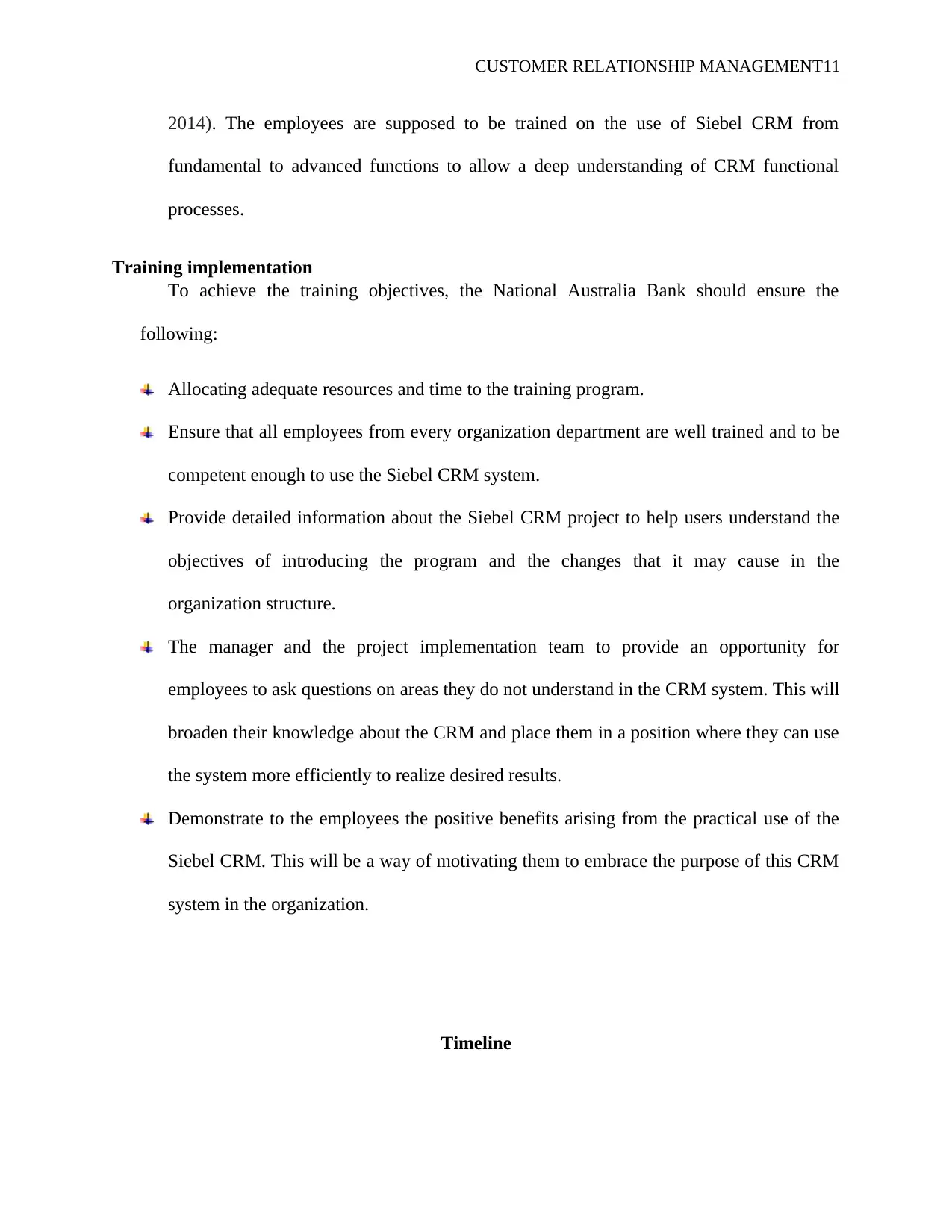
CUSTOMER RELATIONSHIP MANAGEMENT11
2014). The employees are supposed to be trained on the use of Siebel CRM from
fundamental to advanced functions to allow a deep understanding of CRM functional
processes.
Training implementation
To achieve the training objectives, the National Australia Bank should ensure the
following:
Allocating adequate resources and time to the training program.
Ensure that all employees from every organization department are well trained and to be
competent enough to use the Siebel CRM system.
Provide detailed information about the Siebel CRM project to help users understand the
objectives of introducing the program and the changes that it may cause in the
organization structure.
The manager and the project implementation team to provide an opportunity for
employees to ask questions on areas they do not understand in the CRM system. This will
broaden their knowledge about the CRM and place them in a position where they can use
the system more efficiently to realize desired results.
Demonstrate to the employees the positive benefits arising from the practical use of the
Siebel CRM. This will be a way of motivating them to embrace the purpose of this CRM
system in the organization.
Timeline
2014). The employees are supposed to be trained on the use of Siebel CRM from
fundamental to advanced functions to allow a deep understanding of CRM functional
processes.
Training implementation
To achieve the training objectives, the National Australia Bank should ensure the
following:
Allocating adequate resources and time to the training program.
Ensure that all employees from every organization department are well trained and to be
competent enough to use the Siebel CRM system.
Provide detailed information about the Siebel CRM project to help users understand the
objectives of introducing the program and the changes that it may cause in the
organization structure.
The manager and the project implementation team to provide an opportunity for
employees to ask questions on areas they do not understand in the CRM system. This will
broaden their knowledge about the CRM and place them in a position where they can use
the system more efficiently to realize desired results.
Demonstrate to the employees the positive benefits arising from the practical use of the
Siebel CRM. This will be a way of motivating them to embrace the purpose of this CRM
system in the organization.
Timeline
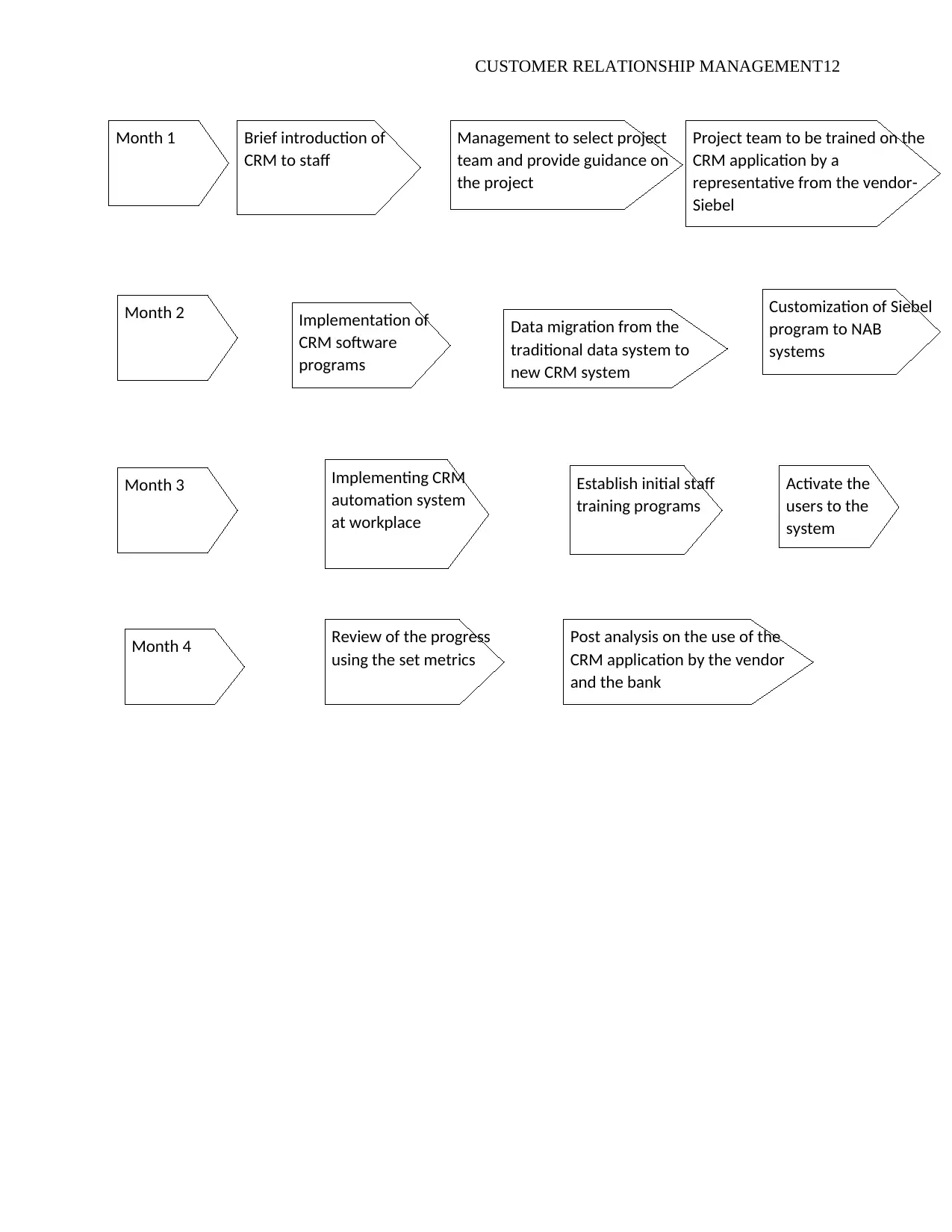
CUSTOMER RELATIONSHIP MANAGEMENT12
Month 1 Brief introduction of
CRM to staff
Management to select project
team and provide guidance on
the project
Project team to be trained on the
CRM application by a
representative from the vendor-
Siebel
Month 2 Implementation of
CRM software
programs
Data migration from the
traditional data system to
new CRM system
Customization of Siebel
program to NAB
systems
Month 3 Implementing CRM
automation system
at workplace
Establish initial staff
training programs
Activate the
users to the
system
Month 4 Review of the progress
using the set metrics
Post analysis on the use of the
CRM application by the vendor
and the bank
Month 1 Brief introduction of
CRM to staff
Management to select project
team and provide guidance on
the project
Project team to be trained on the
CRM application by a
representative from the vendor-
Siebel
Month 2 Implementation of
CRM software
programs
Data migration from the
traditional data system to
new CRM system
Customization of Siebel
program to NAB
systems
Month 3 Implementing CRM
automation system
at workplace
Establish initial staff
training programs
Activate the
users to the
system
Month 4 Review of the progress
using the set metrics
Post analysis on the use of the
CRM application by the vendor
and the bank
⊘ This is a preview!⊘
Do you want full access?
Subscribe today to unlock all pages.

Trusted by 1+ million students worldwide
1 out of 16
Related Documents
Your All-in-One AI-Powered Toolkit for Academic Success.
+13062052269
info@desklib.com
Available 24*7 on WhatsApp / Email
![[object Object]](/_next/static/media/star-bottom.7253800d.svg)
Unlock your academic potential
Copyright © 2020–2025 A2Z Services. All Rights Reserved. Developed and managed by ZUCOL.





